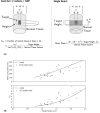Why Do Both Mean Dose and V ≥x Often Predict Normal Tissue Outcomes?
- PMID: 36092989
- PMCID: PMC9450075
- DOI: 10.1016/j.adro.2022.101039
Why Do Both Mean Dose and V ≥x Often Predict Normal Tissue Outcomes?
Figures




Similar articles
-
Potential for reduced toxicity and dose escalation in the treatment of inoperable non-small-cell lung cancer: a comparison of intensity-modulated radiation therapy (IMRT), 3D conformal radiation, and elective nodal irradiation.Int J Radiat Oncol Biol Phys. 2003 Nov 1;57(3):875-90. doi: 10.1016/s0360-3016(03)00743-0. Int J Radiat Oncol Biol Phys. 2003. PMID: 14529795
-
The feasibility study of using multiple partial volumetric-modulated arcs therapy in early stage left-sided breast cancer patients.J Appl Clin Med Phys. 2012 Sep 6;13(5):3806. doi: 10.1120/jacmp.v13i5.3806. J Appl Clin Med Phys. 2012. PMID: 22955645 Free PMC article.
-
Differences in prescribed Kt/V and delivered haemodialysis dose--why obesity makes a difference to survival for haemodialysis patients when using a 'one size fits all' Kt/V target.Nephrol Dial Transplant. 2013 Nov;28 Suppl 4:iv219-23. doi: 10.1093/ndt/gft237. Epub 2013 Jun 19. Nephrol Dial Transplant. 2013. PMID: 23787543
-
A theoretical investigation of optimal target-dose conformity in gamma knife radiosurgery.Med Phys. 2011 May;38(5):2812-9. doi: 10.1118/1.3582945. Med Phys. 2011. PMID: 21776818
-
Hearing Outcomes After Stereotactic Radiosurgery for Vestibular Schwannomas : Mechanism of Hearing Loss and How to Preserve Hearing.Adv Tech Stand Neurosurg. 2016;(43):3-36. doi: 10.1007/978-3-319-21359-0_1. Adv Tech Stand Neurosurg. 2016. PMID: 26508404 Review.
References
-
- Bates JE, Keshavarz H, Rancati T, et al. Cardiac disease in childhood cancer survivors treated with radiotherapy: A systematic review. Int J Radiat Oncol Biol Phys. Submitted. - PubMed
-
- Milgrom SA, van Luijk P, Pino R, et al. Salivary and dental complications in childhood cancer survivors treated with radiation therapy to the head and neck: A pediatric normal tissue effects in the clinic (PENTEC) comprehensive review. In press. - PubMed
Grants and funding
LinkOut - more resources
Full Text Sources

